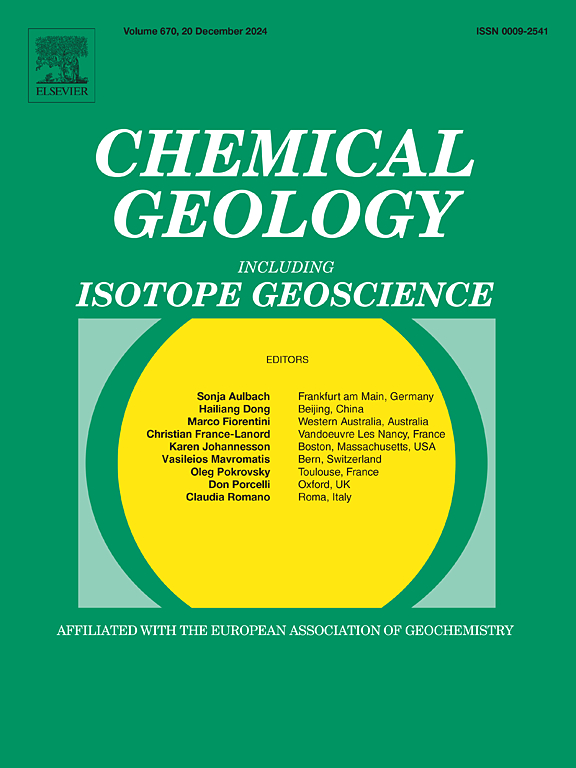Apatite as an indicator of tectono-magmatic evolution of silica-undersaturated to silica-oversaturated rocks on the NW Indian Plate margin
IF 3.6
2区 地球科学
Q1 GEOCHEMISTRY & GEOPHYSICS
引用次数: 0
Abstract
Permo-Carboniferous intrusive rocks situated on the NW boundary of the Indian Plate between the Main Mantle Thrust (MMT) and Main Boundary Thrust (MBT) have tremendous potential for enhancing our knowledge of regional tectono-magmatic activity in Pakistan, yet these units have received only limited investigation to date. Here, we examine the petrology, apatite geochemistry and Sr-Nd isotopes, and geochronology of the silica-undersaturated (sodalite syenite and nepheline syenite), silica-saturated (monzonite and quartz syenite), and silica-oversaturated (granite and quartz monzonite) intrusive suites of the Ambela Granitic Complex (AGC) in northern Pakistan. Cathodoluminescent (CL) images of apatite in the three suites show mostly oscillatory zonation and a homogenous texture. The apatite chemistry of three intrusives is characterized by high fluorine (F), rare earth element (REE), yttrium (Y), and thorium (Th) contents, and low levels of chlorine (Cl), iron oxide (FeO) and magnesium oxide (MgO), suggesting a magmatic origin. The three suites exhibit variation in Sr-Nd isotopes, i.e., 87Sr/Sr86i = 0.7035 to 0.7057 and εNd(t) = +0.3 to +6.0 for the silica-undersaturated group, 87Sr/Sr86i = 0.7044 to 0.7205 and εNd(t) = +1.8 to +3.8 for the silica-saturated group, and 87Sr/Sr86i = 0.7075 to 0.7186 and εNd(t) = −2.5 to +1.2 for the silica-oversaturated group. Garnet stability field indicators in the nepheline syenite imply a deeply sourced magma, with Sr-Nd isotopic, and trace-element compositions of the apatite indicating formation in the subcontinental lithospheric mantle. In contrast, the silica-oversaturated melts formed during magma ascent through crustal interactions at a range of depths, with their apatites showing affinity with A-type granites. Apatite grains from the three magmatic groups show distinctive Sr, Eu and Y patterns, reflecting less fractionation of the silica-undersaturated and -saturated suites than of the silica-oversaturated suite. Furthermore, apatites of the former suites have higher Eu/Eu* and SO3 and lower Ce/Ce* than those of the latter suite, suggesting development under more oxidizing magmatic conditions. TDM2 ages demonstrate parent material of Mesoproterozoic to Neoproterozoic age, whereas LA-ICP-MS U-Pb dating of magmatic apatite indicates cooling of all suites concurrently at ∼322–262 Ma. The latter ages document significant magmatic activity in the study region during the Late Carboniferous to Middle Permian, probably in connection with rifting of the northern margin of the supercontinent Gondwana, leading to opening of the Neo-Tethys Ocean.

磷灰石作为印度西北板块边缘硅欠饱和到硅过饱和岩石构造岩浆演化的标志
位于印度板块西北边界主地幔逆冲(MMT)和主边界逆冲(MBT)之间的二叠纪-石炭系侵入岩具有巨大的潜力,可以增强我们对巴基斯坦区域构造-岩浆活动的认识,但迄今为止对这些单元的研究还很有限。本文研究了巴基斯坦北部Ambela花岗岩杂岩(AGC)中硅不饱和(钠长石正长岩和榴石正长岩)、硅饱和(二长岩和石英正长岩)和硅过饱和(花岗岩和石英二长岩)侵入岩套的岩石学、磷灰石地球化学和Sr-Nd同位素,以及年代学。三套磷灰石的阴极发光(CL)图像显示大部分是振荡带和均匀的结构。三种侵入岩的磷灰石化学特征均表现为高氟(F)、稀土(REE)、钇(Y)、钍(Th)含量,低氯(Cl)、氧化铁(FeO)、氧化镁(MgO)含量,表明其岩浆成因。三个组的Sr-Nd同位素变化特征为:硅欠饱和组87Sr/Sr86i = 0.7035 ~ 0.7057, εNd(t) = +0.3 ~ +6.0;硅饱和组87Sr/Sr86i = 0.7044 ~ 0.7205, εNd(t) = +1.8 ~ +3.8;硅过饱和组87Sr/Sr86i = 0.7075 ~ 0.7186, εNd(t) = - 2.5 ~ +1.2。霞石正长岩中的石榴石稳定性场指示岩浆来源较深,其Sr-Nd同位素和磷灰石的微量元素组成指示其形成于次大陆岩石圈地幔。石英过饱和熔体是在岩浆上升过程中通过一定深度的地壳相互作用形成的,其磷灰石与a型花岗岩表现出亲和关系。三个岩浆岩群的磷灰石颗粒表现出明显的Sr、Eu和Y型,反映出硅欠饱和和饱和套件的分选率低于硅过饱和套件。前组磷灰石Eu/Eu*和SO3比值高于后组磷灰石,Ce/Ce*比值低于后组磷灰石,说明前组磷灰石发育的岩浆氧化性较强。TDM2年龄表明母物质为中元古代至新元古代,而岩浆磷灰石的LA-ICP-MS U-Pb定年表明所有组同时在~ 322-262 Ma冷却。后一时代记录了研究区晚石炭世至中二叠世期间的重大岩浆活动,可能与冈瓦纳超大陆北缘的裂谷作用有关,导致新特提斯洋的打开。
本文章由计算机程序翻译,如有差异,请以英文原文为准。
求助全文
约1分钟内获得全文
求助全文
来源期刊

Chemical Geology
地学-地球化学与地球物理
CiteScore
7.20
自引率
10.30%
发文量
374
审稿时长
3.6 months
期刊介绍:
Chemical Geology is an international journal that publishes original research papers on isotopic and elemental geochemistry, geochronology and cosmochemistry.
The Journal focuses on chemical processes in igneous, metamorphic, and sedimentary petrology, low- and high-temperature aqueous solutions, biogeochemistry, the environment and cosmochemistry.
Papers that are field, experimentally, or computationally based are appropriate if they are of broad international interest. The Journal generally does not publish papers that are primarily of regional or local interest, or which are primarily focused on remediation and applied geochemistry.
The Journal also welcomes innovative papers dealing with significant analytical advances that are of wide interest in the community and extend significantly beyond the scope of what would be included in the methods section of a standard research paper.
 求助内容:
求助内容: 应助结果提醒方式:
应助结果提醒方式:


